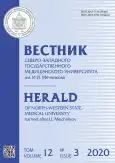Possibilities of nailfold capillaroscopy in the differential diagnosis of immuno-inflammatory and rheumatological diseases
- Authors: Penin I.N.1,2, Maslyanskiy A.L.1, Konradi A.O.1,3, Mazurov V.I.4
-
Affiliations:
- Almazov National Medical Research Centre
- Leningrad Regional Clinical Hospital
- ITMO University
- North-Western State Medical University named after I.I. Mechnikov
- Issue: Vol 12, No 3 (2020)
- Pages: 21-26
- Section: Original study article
- URL: https://journal-vniispk.ru/vszgmu/article/view/43996
- DOI: https://doi.org/10.17816/mechnikov43996
- ID: 43996
Cite item
Abstract
This article considers capillaroscopic changes in the patients with systemic sclerosis compared to the patients with a group of rheumatological diseases (rheumatoid arthritis, polymyositis, osteoarthritis) and the patients with idiopathic pulmonary hypertension. All the patients diagnosed with systemic sclerosis according to nailfold capillaroscopy had a characteristic combination of capillary disorders (Raynaud’s syndrome): the expansion of all three segments of the capillary loop, the “loss” of capillaries, and the destruction of the nail fold. In the comparison groups, the capillaroscopic picture was represented by single pathological changes that did not add up to the pathognomonic scleroderma patterns, with the exception of the groups with dermato/polymyositis, where 2 patients had significant Raynaud’s syndrome. There were also significant differences in the density of the capillaries in the patients with systemic sclerosis in comparison with the other groups.
Full Text
##article.viewOnOriginalSite##About the authors
Ilya N. Penin
Almazov National Medical Research Centre; Leningrad Regional Clinical Hospital
Author for correspondence.
Email: md_pin@mail.ru
SPIN-code: 7904-5650
Rheumatologist
Russian Federation, Saint-PetersburgA. L. Maslyanskiy
Almazov National Medical Research Centre
Email: esc_4@mail.ru
ORCID iD: 0000-0003-2427-4148
SPIN-code: 5698-7797
Senior Researcher of Rheumatology Department, Almazov National Medical Research Centre
Russian Federation, Saint PetersburgA. O. Konradi
Almazov National Medical Research Centre; ITMO University
Email: konradi@almazovcentre.ru
ORCID iD: 0000-0001-8169-7812
SPIN-code: 2298-8269
MD, Professor, Corresponding Member Russian Academy of Sciences, Deputy General Director for Science, Head of the Research Department of Hypertension
Russian Federation, Saint PetersburgVadim I. Mazurov
North-Western State Medical University named after I.I. Mechnikov
Email: maz.nwgmu@yandex.ru
ORCID iD: 0000-0002-0797-2051
SPIN-code: 6823-5482
D. Sci. (Med.), Prof., RAS academician, Head of the research institute of Rheumatology, head of Department of Therapy, Rheumatology, Examination of Temporary Disability and Quality of Medical Care named after E.E.Eichwald
Russian Federation, Saint-PetersburgReferences
- Maricq HR, LeRoy EC. Patterns of finger capillary abnormalities in connective tissue disease by “wide-field” microscopy. Arthritis Rheum. 1973;16(5):619-628. https://doi.org/10.1002/art.1780160506.
- Bollinger A, Jäger K, Roten A, et al. Diffusion, pericapillary distribution and clearance of Na-fluorescein in the human nailfold. Pflugers Arch. 1979;382(2):137-143. https://doi.org/10.1007/bf00584215.
- Bukhari M, Herrick AL, Mooreet T, al. Increased nailfold capillary dimensions in primary Raynaud’s phenomenon and systemic sclerosis. Br J Rheumatol. 1996;35(11):1127-1131. https://doi.org/10.1093/rheumatology/35.11.1127.
- Grassi W, Core P, Carlino G, et al. Labial capillary microscopy in systemic sclerosis. Ann Rheum Dis. 1993;52(8): 564-569. https://doi.org/10.1136/ard.52.8.564.
- Cutolo M, Sulli A, Pizzorni C, Accardo S. Nailfold videocapillaroscopy assessment of microvascular damage in systemic sclerosis. J Rheumatol. 2000;27(1):155-160.
- Smith V, Pizzorni C, De Keyser F, et al. Reliability of the qualitative and semiquantitative nailfold videocapillaroscopy assessment in a systemic sclerosis cohort: A two-centre study. Ann Rheum Dis. 2010;69(6):1092-1096. https://doi.org/10.1136/ard.2009.115568.
Supplementary files

















